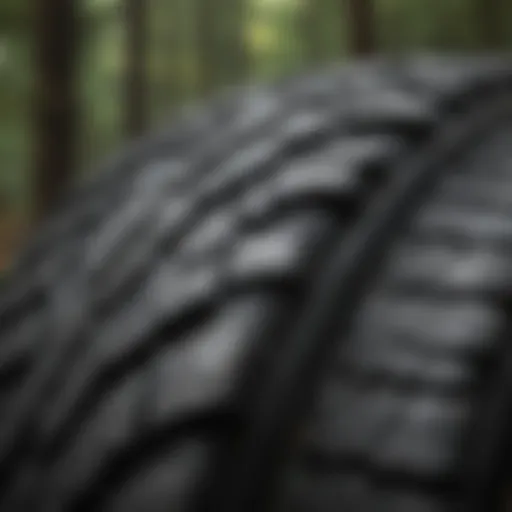Unveiling the Intricacies of Climbing Rigging Equipment for Arborists


Evergreen Trees Species
Forest Management Techniques
Climate Change Impact on Evergreen Forests
Management and Preservation of Evergreen Forests
Outdoor Activities in Evergreen Forests
Introduction
Climbing rigging equipment is a fundamental aspect of arboricultural work, where safety and efficiency are paramount. Forestry professionals rely on a range of specialized gear to navigate tree care operations effectively. This article delves deep into the world of climbing rigging equipment, offering a comprehensive guide for those in the arboriculture field.
Overview of Climbing Rigging Equipment
Importance of Proper Gear
Proper gear is the cornerstone of safe and successful climbing in forestry settings. Each piece of equipment plays a crucial role in ensuring the well-being of the climber and the smooth progression of tasks. From ropes to harnesses, pulleys, and carabiners, the right gear can make all the difference in challenging tree care scenarios.
Forestry professionals must meticulously select their gear to match the specific demands of the job at hand. The importance of proper gear cannot be overstated, as it directly impacts the climber's safety and overall efficiency. By choosing gear that meets industry standards and personal comfort preferences, arborists can execute their tasks with confidence and precision.
Essential Components
Essential components of climbing rigging equipment encompass a range of gear that is indispensable for arborists. Each component serves a unique purpose in the rigging process, contributing to the overall success of tree care operations. Ropes are the lifeline of climbers, harnesses provide crucial support and stability, pulleys aid in transportation and redirecting forces, and carabiners securely connect gear pieces.
These essential components are designed to withstand rigorous use and meet strict safety requirements. Arborists must understand the characteristics and functionality of each component to utilize them effectively in various climbing scenarios. The proper care and maintenance of these components are also vital to ensuring their longevity and performance in the field.
Ropes
In the realm of forestry work, ropes occupy a pivotal role in ensuring both safety and efficiency during climbing and rigging operations. Ropes are not just tools but lifelines for arborists and forestry professionals, providing crucial support and stability in challenging environments. They serve as the primary means of anchoring, ascending, descending, and maneuvering through tree canopies with precision and control. The selection of the right ropes is paramount as they can make the difference between a successful operation and a risky endeavor. Hence, understanding the nuances of climbing ropes is essential for anyone engaged in arboricultural activities.
Types of Climbing Ropes
Dynamic Ropes


Dynamic ropes are designed to stretch under load, providing a cushioning effect that reduces the impact force in case of falls. This elasticity makes dynamic ropes the preferred choice for climbing situations where falls are likely, such as recreational climbing and working at heights. The core characteristic of dynamic ropes lies in their ability to absorb energy, offering a safer experience for climbers. While their stretchiness can be advantageous in certain scenarios, it may also lead to a greater degree of elongation, which could impact precision in rigging setups.
Static Ropes
Unlike dynamic ropes, static ropes have minimal stretch, making them ideal for scenarios where stability and minimal elongation are crucial. Their lack of give works in favor of situations requiring precise positioning and control, such as rigging heavy loads or working in environments where movement needs to be restricted. Static ropes excel in scenarios where maintaining a consistent length and stable anchor points are essential. However, the lack of elasticity may result in higher impact forces on the climber or gear in case of falls, necessitating a careful assessment of the specific requirements of the task at hand.
Rope Care and Maintenance
Inspecting for Damage
Regular inspection of climbing ropes is integral to ensuring their safety and reliability. By meticulously examining ropes for any signs of wear, tear, abrasion, or other forms of damage, climbers can preemptively replace compromised ropes, thus mitigating the risk of potential accidents. Inspecting ropes before each use and after any significant impact or load-bearing activity is imperative to catch any issues early on and prevent catastrophic failures during critical moments.
Cleaning and Storage Tips
Properly cleaning and storing climbing ropes is key to prolonging their lifespan and maintaining their structural integrity. It is essential to remove dirt, debris, and contaminants that may compromise the rope's material over time. Cleaning should be done using mild soap and water, avoiding harsh chemicals that could weaken the rope fibers. Furthermore, ropes should be stored in a cool, dry place away from direct sunlight and corrosive substances to prevent degradation. Coiling the rope correctly and hanging it in a dry, well-ventilated area can prevent kinks and ensure the rope remains supple and easy to handle.
Harnesses
Harnesses play a pivotal role in the safety and functionality of climbing rigging equipment for forestry professionals. These pieces of gear are crucial for the secure attachment of arborists to ropes, providing the necessary support and protection while working at heights. Harnesses come in various types and designs, each serving specific purposes to cater to the diverse needs of tree care operations.
Types of Harnesses
Sit Harness
Sit harnesses are designed to offer comfortable support to climbers during suspension. Their key characteristic lies in their ergonomic design, which allows arborists to stay suspended in a sitting position without discomfort for extended periods. Sit harnesses are widely favored for their ergonomic designs, promoting ease of movement and enhanced work efficiency. The unique feature of sit harnesses is their padded waistbelt and leg loops, providing cushioning and support while distributing the climber's weight evenly. While sit harnesses offer comfort and support, they may have limitations in terms of flexibility compared to other harness types.
Chest Harness
Chest harnesses are essential for maintaining the climber's upright position and preventing inversion during falls. Their primary function is to distribute the impact force across the chest region to minimize injury risks. Key characteristics of chest harnesses include adjustable straps and padding to ensure a snug fit and optimal comfort for the user. Chest harnesses are a popular choice for their ability to enhance safety by preventing hazardous body positions in case of sudden stops or impacts. The unique feature of chest harnesses is their front attachment point, enabling swift and secure connections to other climbing rigging equipment. While chest harnesses excel in safety measures, they may restrict upper body movement to some extent.
Full Body Harness
Full body harnesses offer comprehensive protection by securing the climber's entire body. These harnesses are crucial for arborists working in challenging environments or situations where falls are multifaceted. The key characteristic of full body harnesses is the presence of additional attachment points on the chest and shoulders, ensuring balanced support and weight distribution in critical conditions. Full body harnesses are a beneficial choice for their all-encompassing safety features and versatility in high-risk work settings. The unique feature of full body harnesses is their integrated design, covering the torso, hips, and legs for maximum safety and security. While full body harnesses provide extensive protection, they may be slightly bulkier compared to other harness types.
Fitting and Adjustment


Proper Sizing
Ensuring proper sizing of harnesses is vital to optimize safety and comfort for climbers. The key characteristic of proper sizing lies in achieving a snug fit that prevents slippage or discomfort during movement. Properly sized harnesses offer stability and support, reducing the risk of injuries caused by ill-fitting gear. Unique features of harness sizing include adjustable straps and buckles, allowing users to customize the fit according to their body dimensions. Proper sizing is a popular choice among climbers for its ergonomic benefits and enhanced mobility, enabling them to focus on their tasks without distractions. While proper sizing enhances safety and comfort, it may require periodic adjustments to accommodate varying clothing layers or gear setups.
Adjusting for Comfort and Safety
Harness adjustment plays a critical role in ensuring climber comfort and safety while working at heights. The key characteristic of adjusting harnesses lies in calibrating the fit to minimize pressure points and ensure even weight distribution. Proper adjustment enhances comfort levels, reducing fatigue and promoting prolonged work periods with minimal strain. Unique features of comfort and safety adjustments include padded straps, breathable materials, and intuitive buckles for quick modifications. Adjusting for comfort and safety is a preferred choice among climbers for its adaptability to varying environmental conditions and work requirements. While adjustments enhance comfort and safety, over-tightening or incorrect settings may restrict blood flow or movement, necessitating careful monitoring during prolonged use.
Carabiners
Carabiners are pivotal components in the realm of climbing rigging equipment for forestry professionals. These specialized connectors are designed to secure ropes, harnesses, and various attachments, ensuring optimal safety and efficiency during tree care operations. The selection of appropriate carabiners is crucial, taking into account factors such as weight capacity, lock type, and intended usage. Forestry professionals rely heavily on the reliability and functionality of carabiners to execute their tasks with precision and security.
Types and Functions
Screwgate Carabiners
Screwgate carabiners are renowned for their simple yet effective locking mechanism, providing a secure closure that minimizes the risk of accidental openings. These carabiners are favored for their versatility and reliability, making them a popular choice among forestry professionals for connecting critical gear. The key characteristic of screwgate carabiners lies in their manual locking mechanism, requiring the user to twist and secure the gate shut for added safety. While this manual process may seem time-consuming, it offers the benefit of an extra layer of protection against unintended releases, making screwgate carabiners ideal for high-stress situations in arboricultural settings.
Auto-locking Carabiners
Auto-locking carabiners feature an automatic locking mechanism that engages when the gate is closed, minimizing the possibility of human error in securing the connection. This type of carabiner offers swift and convenient operation, particularly beneficial for scenarios where speed and efficiency are essential. The key characteristic of auto-locking carabiners is their self-locking feature upon closure, representing a significant advancement in user-friendly design for forestry professionals. However, users must ensure proper maintenance and inspection of auto-locking mechanisms to uphold their dependable functionality and prevent potential malfunctions during critical operations.
Twist-lock Carabiners
Twist-lock carabiners incorporate a twist-to-lock system that provides a secure closure with a simple manual twist motion. These carabiners offer a balance between the instantaneous locking of auto-locking models and the added security of screwgate variants. The key characteristic of twist-lock carabiners is their user-friendly operation, where a quick twist ensures a reliable connection, enhancing the overall fluidity of rigging processes in forestry applications. While twist-lock carabiners offer expedited usability, users must remain vigilant in confirming the proper engagement of the locking mechanism to avoid instances of accidental gate openings.
Pulleys
In the realm of climbing rigging equipment for forestry professionals, pulleys hold a significant role that cannot be overlooked. Pulleys are pivotal components that facilitate the movement and transfer of loads, making them indispensable for various arboricultural tasks. Their design, construction, and functionality directly impact the efficiency and safety of rigging operations.
Varieties of Pulleys
Single Pulleys
Single pulleys, also known as a simple pulley system, are essential tools in rigging setups due to their straightforward yet effective design. Their key characteristic lies in their ability to change the direction of force applied, thereby reducing the effort required for lifting loads. Single pulleys offer a mechanical advantage by distributing the weight evenly, making them a popular choice among forestry professionals for lifting and lowering heavy objects with minimal exertion. Despite their simplicity, single pulleys excel in scenarios where a basic but reliable lifting mechanism is needed.


Double Pulleys
Double pulleys, also referred to as blocks or compound pulleys, consist of two grooved wheels enclosed within a casing. They are favored in rigging applications for their heightened mechanical advantage, enabling users to lift heavier loads with ease. The key characteristic of double pulleys is their ability to decrease the amount of force needed to lift a load by distributing it between the two wheels. This feature makes double pulleys a valuable asset in situations that require efficient load handling and precise control. However, their complexity compared to single pulleys can demand a more intricate setup and maintenance.
Micro Pulleys
Micro pulleys are miniature versions of traditional pulley systems designed to handle lighter loads with precision and agility. These compact pulleys offer a high degree of control in rigging operations where intricate maneuvers are necessary. Their key characteristic lies in their diminutive size and lightweight construction, allowing users to navigate tight spaces and execute delicate movements with ease. Micro pulleys are a beneficial choice for tasks that require finesse and intricate rigging configurations, making them indispensable in specific forestry applications.
Applications in Rigging
Mechanical Advantage Systems
Mechanical advantage systems incorporating pulleys are instrumental in multiplying the lifting capacity and reducing the effort required to hoist heavy objects. By utilizing multiple pulleys in strategic arrangements, mechanical advantage systems can amplify the force applied, enabling forestry professionals to tackle challenging loads efficiently. The key characteristic of these systems is their ability to provide a leverage advantage, allowing users to overcome gravitational forces with minimal input. However, the complexity of setting up and managing mechanical advantage systems requires careful planning and expertise to ensure optimal performance.
Redirects and Tensioning
Redirects and tensioning mechanisms involving pulleys play a vital role in altering the direction of loads and maintaining optimal tension across rigging setups. These devices enable forestry professionals to navigate obstacles, change load directions, and regulate tension levels with precision. The key characteristic of redirects and tensioning systems is their capacity to streamline rigging tasks by ensuring smooth load distribution and control. While effective in enhancing operational efficiency, the use of redirects and tensioning systems requires meticulous attention to detail to prevent potential feedback or slack in the rigging system.
Ascenders and Descenders
In the realm of climbing rigging equipment for forestry professionals, Ascenders and Descenders hold paramount importance due to their critical role in tree care operations. Ascenders and Descenders are essential tools that enable arborists to ascend and descend trees safely and efficiently, enhancing productivity and minimizing risks.
Function and Usage
Ascending Devices:
Ascending Devices are designed to facilitate the upward movement of climbers along the rope. They feature a unique camming mechanism that grips the rope securely, allowing climbers to ascend with ease. Ascending Devices are revered for their reliability and ease of use, making them a preferred choice for forestry professionals. Their key characteristic lies in their ability to provide controlled progress while ascending trees, ensuring climbers can navigate with precision and security. However, one downside of Ascending Devices is the potential for slippage if not properly adjusted or maintained, emphasizing the necessity of regular inspection and upkeep to guarantee safe climbing practices.
Descending Devices:
On the other hand, Descending Devices play a crucial role in facilitating the controlled descent of climbers from heights. Featuring friction control systems, Descending Devices allow arborists to lower themselves safely, contributing to overall work efficiency and safety measures. A key characteristic of Descending Devices is their ability to regulate descent speed according to user preference, enabling climbers to descend at a controlled pace. Their unique feature lies in their versatility, as they can be utilized in various rigging setups for descending tasks. However, it is imperative to note that improper handling or incorrect setup of Descending Devices can lead to accidents, underscoring the importance of proper training and adherence to safety protocols in utilizing these devices in climbing rigging operations.
Conclusion
Safety First
Importance of Training
The essence of training in the context of climbing rigging equipment cannot be overstated. Proper training equips forestry professionals with the knowledge, skills, and techniques required to navigate tree canopies safely and effectively. Through specialized training programs, individuals get familiar with the use of different gear, safety protocols, and emergency procedures, ensuring preparedness for various scenarios encountered during tree care operations. Training instills confidence, fosters competence, and cultivates a culture of safety consciousness among arborists, underscoring the paramount importance of ongoing learning and development in this field.
Regular Equipment Inspections
Regular equipment inspections form the backbone of safety protocols in arboriculture. By routinely checking and maintaining climbing rigging gear, forestry professionals mitigate the risk of accidents and equipment failure while up in the canopy. Inspections help identify wear and tear, potential weaknesses, or defects in equipment, allowing for timely repairs or replacements to uphold safety standards. Regular assessments not only safeguard the well-being of climbers but also prolong the lifespan of gear, optimizing performance and efficiency during tree care tasks. Implementing a rigorous inspection regimen underscores a commitment to safety and professionalism in the forestry industry.



